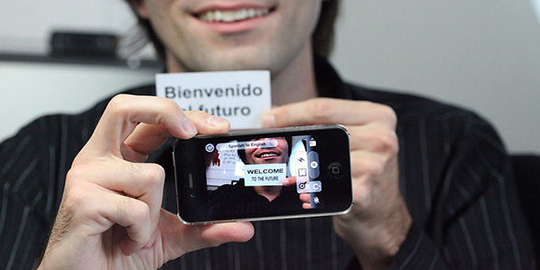
Technology Observatory January 12-18
This week's Technology Observatory brings you the following stories:
- These are the Smart TV platforms we'll see in 2015
- Microsoft unhappy with Google's disclosure of a vulnerability in Windows 8.1
- Google's Translate app to include a simultaneous translation tool
- Spanish citizens to get a new electronic ID card with NFC
- The battle between Google and Facebook for Xiaomi
- Samsung releases (again) its 'first' Tizen phone, with a price tag of around 80 euros
- Microsoft announces there will be live streaming at the Windows 10 event next Wednesday
- Xiaomi attacks the high-end market. And the West as well?
- Goodbye Glass Explorer: Google drops its developers' program
- HTC to unveil the replacement for One on March 1
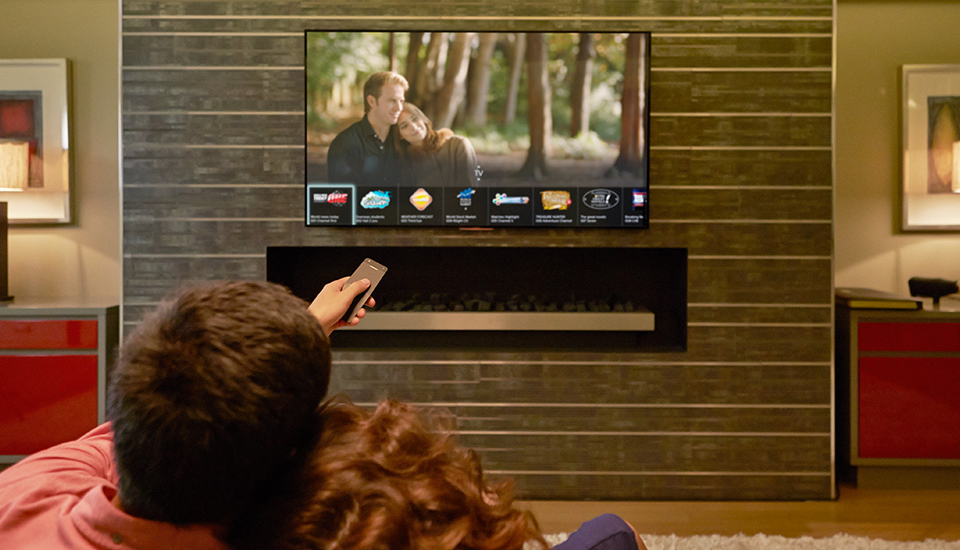
As well as spectacular curved, ultra-slim and nano-glass models, this year's CES brought us some revolutionary television interfaces following the decision by the four leading manufacturers to change their smart TV platform in an attempt to win over users this year. LG, Panasonic, Samsung and Sony all accompanied the presentation of their latest TVs with an upgraded operating system designed to get even more out of television, be it watching programs through the Internet or connecting the set to other devices in the home.
LG AND ITS NEW webOS 2.0
LG has made the fewest changes in this respect, although the update was so necessary that it might well feel like a radical change. The last generation of TV sets came with a brand new attention-grabbing interface based on webOS, taking many by storm, but the models that finally reached the stores turned out to very slow in terms of performance, resulting in a frustrating experience. Conscious of this negative side to its system and keen to offer a smart TV on a par with its televisions, the manufacturer has pulled out all the stops to improve the speed of the menus and boot time by 60 percent. The result is none other than this webOS 2.0, a version that looks just as attractive as the previous generation but is now much faster and more intuitive. We'll have to test it to check out its performance, but we can already see that some of the shortcuts have been improved. For instance, the quick settings don't take up as much of the screen and let you make changes and see the results on the spot. The same goes for the font selector and the shortcuts to the applications, something which leaves a lot to be desired in the current models.
PANASONIC AND FIREFOX OS
Panasonic has gone all out to offer a smart TV that is both complete and functional, but compared with those of its competitors the Smart Viera interface was no way near enough attractive to appeal to users. However, there's a solution to everything, and in the case of Panasonic it's called Firefox OS. The red panda reaches Panasonic televisions with a minimalist and carefully designed interface offering interesting functions like sending content from devices with the Firefox browser, the possibility of installing applications, and the capacity to receive alerts and notifications from other types of devices (including electrical appliances) with Firefox OS. The future ecosystem looks very promising, although it will first mean making a firm commitment to the operating system, so we'll have to wait and see the extent to which Panasonic and other manufacturers decide to include Firefox OS in their equipment. For now, the models that will receive this attractive smart TV are the CX600, CX650, CX800 and CX850.
SAMSUNG AND ITS SWITCH TO TIZEN
The move by Samsung is quite interesting. The Korean firm has always boasted about having the most attractive and complete platform on the market, with navigation that included gesture control and sections clearly differentiated by content, but now it seems they've captured the intentions of their competitors. Tizen will offer faster and easier navigation, and its interface will be simpler and more minimalist than the previous one, with a design that inevitably recalls the one proposed by LG and its webOS. The platform has also been reinforced with the introduction of a highly desirable application like PlayStation Now, which means that users will be able to run PlayStation games on their television set by accessing the games service in the Sony cloud.
SONY AND ANDROID TV
The Japanese company has been the most surprising in this respect, having abandoned its One-Flick Entertainment (though it won't disappear completely) to integrate Android TV as its main operating system. This change will allow it to offer many more functions, including interesting ones like Google Cast, which lets you copy images from your mobile devices without having to connect a Chromecast. It will also be possible to execute voice commands, access Google Play to rent movies, music and even install games to play with a wireless control, and share photos with family and friends by connecting up to 10 devices at once. The Sony series that will come with Android TV this year are the X94C/93C, X90C, X85X, X83C, W85C/80C and W75C.
Last summer Google announced the creation of a research group called Project Zero whose mission was to detect and report security problems in its own software and that of other companies. On September 30 the team alerted Microsoft about the existence of a vulnerability in Windows 8.1 that could allow third parties to seize control of a device with that operating system. The alert was accompanied by a 90-day deadline for Redmond to solve the problem before Google went public with it. And going public is precisely what Google did last week. The 90 days were up and Microsoft hadn't solved the problem, so the Google research group disclosed the vulnerability, allowing anyone to find out about it and describing how it could be exploited. Redmond didn't like that and is now working on a solution. In fact, so put out was it by the disclosure that Chris Betz, senior director at the Microsoft Security Response Center (MSRC), decided to publish a note regretting the action by the Mountain View people and calling for companies to stand together over security issues. Betz was highly critical of Google's action in the matter. It seems that Redmond had asked the Project Zero team to delay disclosure of the bug until January 13, when they had planned to issue a fix through their well-known Patch Tuesday. Unfortunately, Mountain View ignored the request, which is precisely what is behind Microsoft's response arguing for more collaboration in situations like these. Microsoft doesn't agree with Google's strategy of having a research team looking for vulnerabilities in competitors' products, stepping up the pressure by imposing a deadline to solve them, and threatening to disclose them if the deadline passes and a solution hasn't been provided. Not all vulnerabilities imply the same level of threat and often there isn't a quick solution or one that is easy to apply, so issuing a countdown to disclosure isn't the best way to encourage a fix. Redmond would prefer the researchers to alert companies privately about possible vulnerabilities and work with them on a solution, rather than imposing time limits and threatening disclosure.
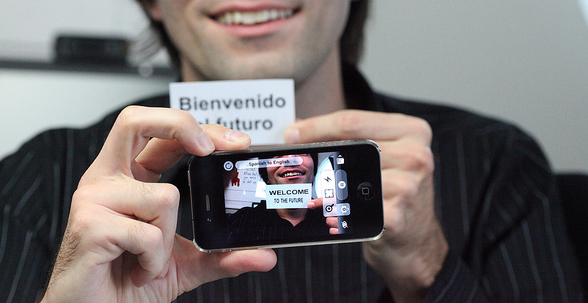
Google is about to update its Translation mobile app by including a new simultaneous voice translation function. The Internet giant is following in the footsteps of Microsoft, which last December included a simultaneous translation tool in its Skype messaging service. According to Bits, the technology blog published in the New York Times, Google will soon be announcing updates to its Google Translate app, which already offers written translation in 90 languages, automatic translation of websites, and even the possibility of listening to spoken translations in certain languages. Soon the application will be able to recognize which language someone is using, and if it's one of the most widely spoken ones it will offer a written translation of their words. That is the basic difference with Skype's Translator. While Google Translate will only offer a written translation of the words used by a speaker of a foreign language, the Microsoft tool will permit both a written and audio translation. For now, the preliminary version of the latter is available in audio and text for English and Spanish, and in text mode for another 40 languages. Meanwhile, the changes in the Google Translate application will mean that you will able to use your smartphone camera to translate text in another language into your native tongue. This is thanks to Google's recent acquisition of the start-up Quest Visual, which created an application that permitted precisely this same function in Android, iOS and Google Glass devices. As reported in The Next Web, this Google Translate novelty will be particularly useful for language students, travelers and those who work in the business world when they need to communicate with speakers of other languages. According to figures published by Google, Translate has been installed more than 100 million times on Android phones, most of which will be able to run this latest update, and has 500 million active users per month in all its versions. Talking with the NYT, the director of engineering at Google Translate, Macduff Hughes, said that with 80%-90% of the Internet written in only 10 languages, translation is a critical learning tool for many users.
Electronic ID cards (DNIe) have not taken off in Spain as successfully as the government and citizens had hoped (not to mention the nightmare of configuring them on non-Windows computers), but this morning the Interior Ministry unveiled a new version of the DNIe called 3.0. So how does this new ID card differ from its predecessor? In fact, it's the same as the previous version but now includes NFC, which means it should be possible to link it up with your mobile terminal so that you can sign documents directly from the mobile browser without needing anything else. For the moment, the only thing promised by the new DNIe is a chip with greater security and encryption, NFC, and the same legal validity as your handwritten signature or the previous version. According to the National Police, it is already available for renewals and new ID cards in Lleida, and will soon be rolled out in all the usual police renewal points. What's more, you won't need any special drivers or adapters to use it – you'll be able to handle affairs from your cell phone or browser wirelessly and they'll have the same electronic validity. The arrival of electronic ID cards with NFC is good news, but it needs to be accompanied by an administration that is capable of carrying out electronic procedures competently. There are still far too many institutions that force you to use Internet Explorer 6 or 7 for any matter, however trivial it may be.
Facebook wants to invest in Xiaomi, the Chinese cell phone (and much more) company. This is undoubtedly one of the most important events in recent times in mobile technology: the rise of China as a force to be reckoned with, and Xiaomi as its best ambassador. What does Xiaomi have that has managed to convince so many users? Why have other Asian Giant companies not had the same success? And more curious still, why are we now hearing rumors about Facebook wanting to invest in Xiaomi? What does a social media site want with a cell phone company? Let's try and put a few cards on the table.
Xiaomi, the world's most valuable technology start-up
Xiaomi's figures are impressive. As with everything related to China, the orders of magnitude are not comparable to those of the western world. We are talking about a company that still hasn't managed to internationalize its products but boasts exorbitant growth rates, sales and revenues. It is worth around 40 billion dollars, which makes it the most valuable technology company not listed on the stock market. And that has attracted a lot of attention.
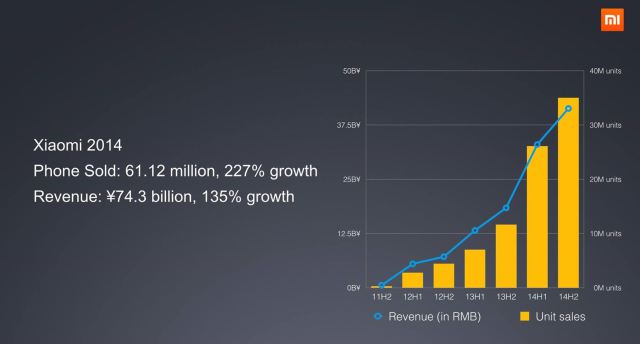
Expanding outside China is no small thing for Xiaomi as it will need to meet several challenges that it doesn't have in its own country. The first is convincing a community of users that may not have the same tastes. Then there are the problems of distribution and guarantees. Adapting to local legislation on production rights is another. And all of this while maintaining its products at the same price, which after all is the real reason why users have noticed them.
Facebook and Xiaomi: China is very tempting market
In the last financing round, Xiaomi raised 1 billion dollars. In recent years Facebook has shown that it has a very good eye where finance is concerned and has not hesitated to snatch up companies it thinks might be important in the future. However, with Xiaomi they're not talking about buying it but making a small investment. A limited amount of money is involved but sufficient to provide it with an alliance that may turn out to be highly profitable. Every company in the West is looking for ways to break into China. Apple has struck an alliance with China Mobile, Google has not made much headway in spite of Android being the most widely used system there, and Facebook is engaged in a battle with the country's leading social media (in fact China is inaccessible). Xiaomi CEO Lei Jun and Mark Zuckerberg have apparently met to discuss these points. In the end, they didn't reach an agreement, but it's always interesting to discuss possibilities, to ponder moves between major companies. We'll have to keep our ear to the ground in coming months in case they agree to a different type of alliance.
Xiaomi has the vibrant community that Google lacks
Just as you would imagine. If anyone is keeping a close eye on Xiaomi, it's Google. The search engine knows that the Chinese company represents a very important part of Android, and that it currently has no plans to use Google Play Services. Google is keen to halt this advance with initiatives like Android One, the aim of which is precisely to emphasize the importance of having Google support in the low end. ZTE, Huawei, Honor and Lenovo/Motorola all collaborate on a regular basis with Mountain View and have a pricing policy just as aggressive as Xiaomi. However, the latter company can boast a very strong community of fans, one that prefers to use the brand's services. In fact, this is what makes Xiaomi so special and why Facebook might be so interested in it. Mi is a style, a product philosophy, and it has legions of fans behind it. They have achieved more than just a good product, and if Facebook manages to secure a foothold in that ecosystem it could do a lot of damage. The social media site is not looking for a manufacturer for a new cell phone, and probably not a financial return either. Facebook buys or invests in companies that reach people, and Xiaomi is one of them.
You might think this is a case of déjà vu, and we wouldn't blame you. Last June Samsung unveiled "its first Tizen phone", but the Z model didn't really take off and before it reached stores it was delayed and then finally canceled. But the company hasn't given up, and it's back now with the Z1, a device that was leaked at the end of December and, unlike its elder brother, is targeted at the low-cost segment and least affluent part of the market. With a 4-inch display (800 x 480 pixels), the smartphone has a 1.2 GHz processor and comes with 768 GB of RAM and 4 GB of internal memory (both boostable with microSD cards). The rear camera has 3.1 megapixels (the front one is of the VGA type) and the 1500 mAh battery offers approximately eight hours of autonomy in conversation mode. It can also support two SIM cards. Specifications like these warrant a very reasonable price tag, and that is precisely what Samsung has done with this smartphone. The Z1 costs around 90 dollars/80 euros, and in view of these characteristics it will first be sold in India (where the company has closed a deal with several telecommunications operators to offer 500 MB of data free for the first six months). We'll have to wait and see what happens with this second invention and whether the terminal is successful enough to make the leap to other markets. It's available in India as from today in white, black and red.
Good news for those of us who are looking forward to the Windows 10 event on Wednesday January 21. Microsoft has just announced in the official Windows blog that it will offer video streaming via that URL so that users around the world can follow the presentation live on the Internet. This is a different story from the event last September, which wasn't broadcast live but simply uploaded to YouTube once the presentation had finished. That option will also be available for the January 21 event, but it seems Microsoft is aiming to cause more of a stir by enabling more people to watch and comment on the event live on social media. The event will start at 9 am San Francisco time, which means 6 pm in Spain.
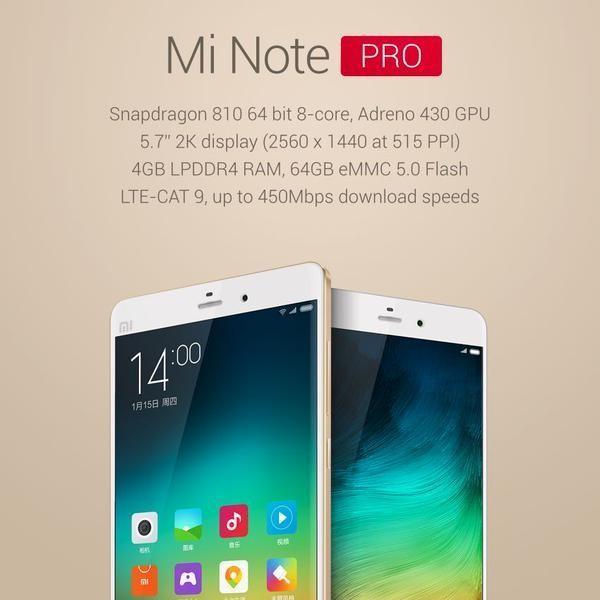
This week's presentation by Xiaomi was extremely illuminating. Having managed to stop any leaks from ruining the magic of the moment, something that lately not even Apple can manage, they unveiled a very interesting product (or maybe two): the Mi Note. Their aim today was to attack the high end of the market with a very competitive price but without neglecting a single aspect. The definitive assault on the West is very close, with lawsuits the only thing stopping this company now. The model they've just launched is actually two models: similar characteristics but different displays (2K or FullHD resolution), different processors (Qualcomm Snapdragon 801 or 810), different RAM memory (3 GB or 4 GB), different internal storage (16 GB or 64 GB), and different connectivity (without or without LTE). The display size (5.7 inches), camera, ultra-slim case (6.95 mm) and protection (Gorilla Glass 3) are the same in both models, so on the outside they look identical. The name was coined for the previous phablet model, Redmi Note – all they've done now is simplify it to Mi Note – and it's no longer a low-end terminal but a state-of-the-art cell phone. What is unusual is the fact that they've copied Samsung's name, possibly in an attempt to cash in on the good reputation associated with the Korean company's model. Will this be a legal issue outside China? Chinese cell phones are getting better and better, and this may well turn out to be the year of the Chinese companies. The Mi Note is certainly worthy of the high end: a lot of care and attention have gone into every aspect, from the design to the specifications that usually set high-end terminals apart, such as the camera. This device makes a very worthy candidate for anyone looking to buy a phablet. And let's not forget the price. The basic Mi Note model will retail at 370 dollars and the advanced one at 450 dollars. These are very competitive and very attractive prices, although we'll have to wait and see what happens in Europe now that the exchange rate with the dollar is in such a state of flux. Xiaomi basically has one challenge: internationalization. Its position in China is enviable, and worldwide they are now the third or fourth most important manufacturer, behind only Samsung and Apple (pending the aggregate data for Lenovo and Motorola, which might just beat them). But most of the 61.1 million terminals sold in 2014 were in Asia. To keep growing they need to reach Europe and the USA. That's something they still have to tackle, and perhaps the time to do it is now, with the release of a flagship like the Mi Note. The terminal certainly has everything it takes to succeed: specifications, a good price (broken down into two models to attack those who want the very latest and those who want to pay less), and a fine design. Will this be Xiaomi's great leap to the West? I personally think they're going to give it a try.
Google Glass has been very quiet in recent months and now it certainly seems that where there's smoke there's fire. According to the Wall Street Journal, Mountain View is ending the Glass Explorer program and therefore halting sales as from today of the current Google Glass model that the developers having been working on. This doesn't mean that Google is abandoning its gadget, merely killing off the project that was aimed at refining the hardware and software. Glass will no longer be a Google X development but will move out of the lab to become more independent. Besides, some time ago Google announced its intention of marketing the gadget this year. What it hasn't yet made clear is how it will do that and what the model will be. Glass at Work, but not Glass Explorer, will continue under its current chief, Ivy Ross, although she will now report to Tony Fadell, formerly of Apple and currently responsible for Nest, who in the coming days will also oversee everything that happens with Google Glass. Recruiting Fadell is a very deliberate move based on his experience at Apple, where he transformed products like the iPod and iPhone. So having him on board at Glass is good news, but the split from Google X probably means that the next advances won't be made public and that what we will see, if everything goes according to plan, is the final product when it's ready. In any case, this doesn't mean that Google has abandoned Glass. After two years up and running, the Explorer program has run its course and now it's time to grow and become more than just a platform for developers.
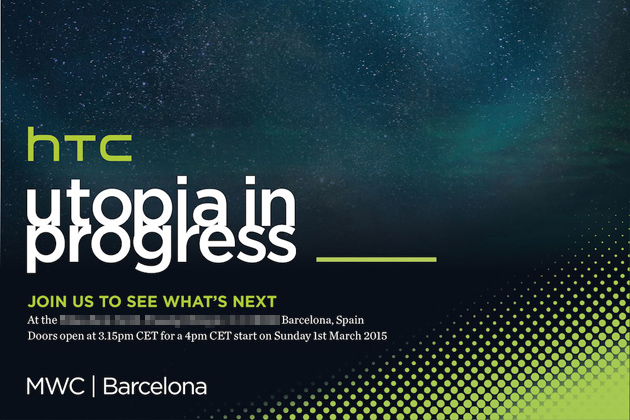
The MWC is just around the corner and now we have the first date on the calendar. HTC has sent out invitations to its press event in Barcelona on March 1, where we might discover its new flagship. If what happened with the One (M8) is anything to go by, the manufacturer will unveil it a few hours before the start of the international fair, so we're probably not far off the mark. The invitation itself doesn't give much away other than the chance to discover a "utopia", although the position of two letters "o", one on top of the other, could be a hint about some type of photographic technology (remember the dual camera in the M8), something they used at the event for the little Re with the slogan "Double Exposure". Could it be that HTC is going to deliver that optical zoom we've heard so much about? Will the new phone include the novel UltraPixel front camera that came with the Desire 826? We'll have the answers to these and many other questions in a few weeks' time, so watch this space as we might be bringing some exciting news.
